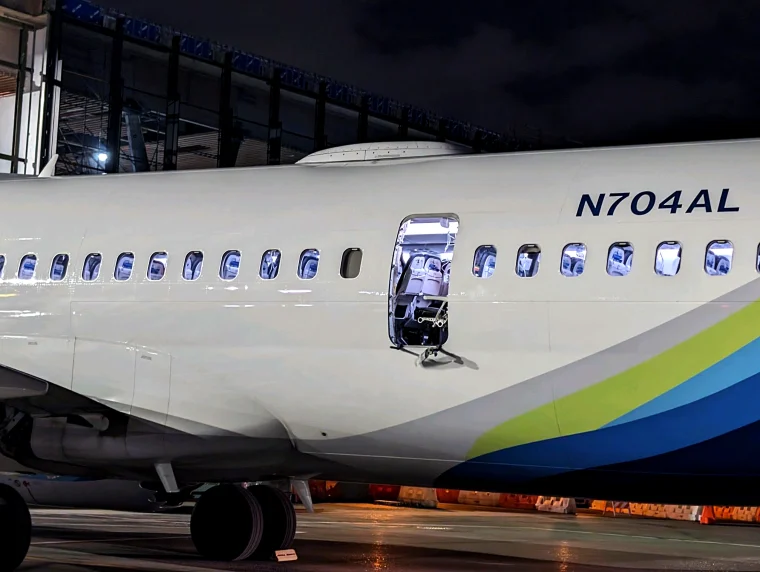
A Portland, Oregon, resident’s lawn has a missing door plug that may hold important clues for the inquiry into why it detached from the plane mid-flight on Friday, authorities announced on Sunday.
Jennifer Homendy, the chair of the National Transportation Safety Board, came to the press conference after it was over to share some good news: “I’m excited to announce that we found the door plug,” she stated.
She acknowledged Bob, a schoolteacher, as the individual who had provided the NTSB two images of the object, and added, “Thank you, Bob.”
“We’re going to go pick that up and make sure that we begin analysing it,” Homendy said.
She also reported finding two cell phones: one by the side of the road and the other in a yard.
After the first full day of the NTSB’s inquiry into the Alaska Airlines Flight 1282 disaster, the head of the organisation stated that some elements were making the investigation more difficult: The incident was unintentionally filmed over on the plane’s cockpit voice recorder, and the door plug was missing at the time.
During a press conference on Sunday night, Homendy expressed regret about the loss of audio data and seemed irritated. “That is unfortunately a loss for us,” he said. “Because that information is key, not just for our investigation, but for improving aviation safety.”
According to Homendy, the NTSB is recommending raising the two-hour minimum duration that must be recorded on the devices to 25 hours. The voice data from the Friday accident in the cockpit would have been preserved at that period.
“I cannot emphasise enough how important that is for safety,” she stated.
Someone neglected to turn off the gadget from Friday’s flight, so it automatically recorded over the relevant speech data, she added. Every two hours, it starts a new recording, erasing the previous one.
Homendy stated, “The circuit breaker was not pulled.”
As the flight crew reported hearing a loud boom and the cabin rapidly depressurized on Friday evening over the Portland region, she detailed confusion and communication challenges on board the Boeing 737 Max 9.
She reported hearing a loud noise.
According to Homendy, the captain also experienced headset issues, and the first officer of the aircraft misplaced her headset during the depressurization. According to her, they activated a speaker for communication.
According to Homendy, “communication was a serious issue.”
A laminated checklist pilots use in an emergency flew out as the cockpit door opened rapidly at the same moment, according to the chair.
The cockpit door “blew open during the explosive decompression,” according to Homendy.
As a flight attendant took three tries to shut the cockpit door, the pilots, she said, went to another fast reference tool, a handbook.
“The flight crew’s actions were truly amazing,” Homendy remarked. “The door being thrown out of the plane was rather powerful. Plenty was happening.
Homendy detailed some of the aircraft’s interior damage. It contained two seats that were left empty by accident but retained enough severe force to cause their frames to become “torqued.”
Row 26 has two seats without headrests and one without a seat back. According to her, damage was discovered along twelve of the plane’s seat rows.
She voiced worry over three infants being carried on the laps of their mothers and fathers. It is recommended, but not mandated, by the NTSB, the FAA, and Alaska Airlines that small children ride in car seats that are buckled up in separate, ticketed seats.
The aircraft involved in the Alaska Airlines incident, the Boeing 737 Max 9, is one of the models that the FAA has ordered to be grounded and has issued a directive demanding inspections before specific aircraft may fly again. 171 aircraft worldwide are impacted by the new directive.
Homendy stated that the “stakes are high” while discussing the work that awaits NTSB investigators in an earlier interview with NBC News on Sunday.
During the press conference on Sunday night, Homendy stated that investigators were examining how the door plug, which is a panel where an optional emergency escape may be installed based on passenger capacity, was fastened prior to the jet blowing up.
Additionally, they are interested in learning more about the air pressurisation alarms that were activated on the aircraft on flights on December 7, Wednesday, and Thursday—the last two days preceding the tragedy.
She said that until the problem could be investigated more fully, the airline has forbidden the aircraft from taking long flights over sea, including flights to Hawaii. That examination was not finished by Friday night’s trip from Portland to Ontario, California, according to Homendy.
She stated that the NTSB had been informed that the problem was “benign” and that it was unclear if the alerts had anything to do with Friday’s disaster.
Homendy stated that although the aircraft’s structural integrity was unharmed after the accident, investigators were primarily concerned with how the door stopper was secured and whether there were any connected issues.
She mentioned four circular “stop fittings” and two hinges at the bottom of the plug that permit a tiny amount of opening for regular checks.
She said, “The goal is to keep that door plug from being pushed out of the air frame.”
